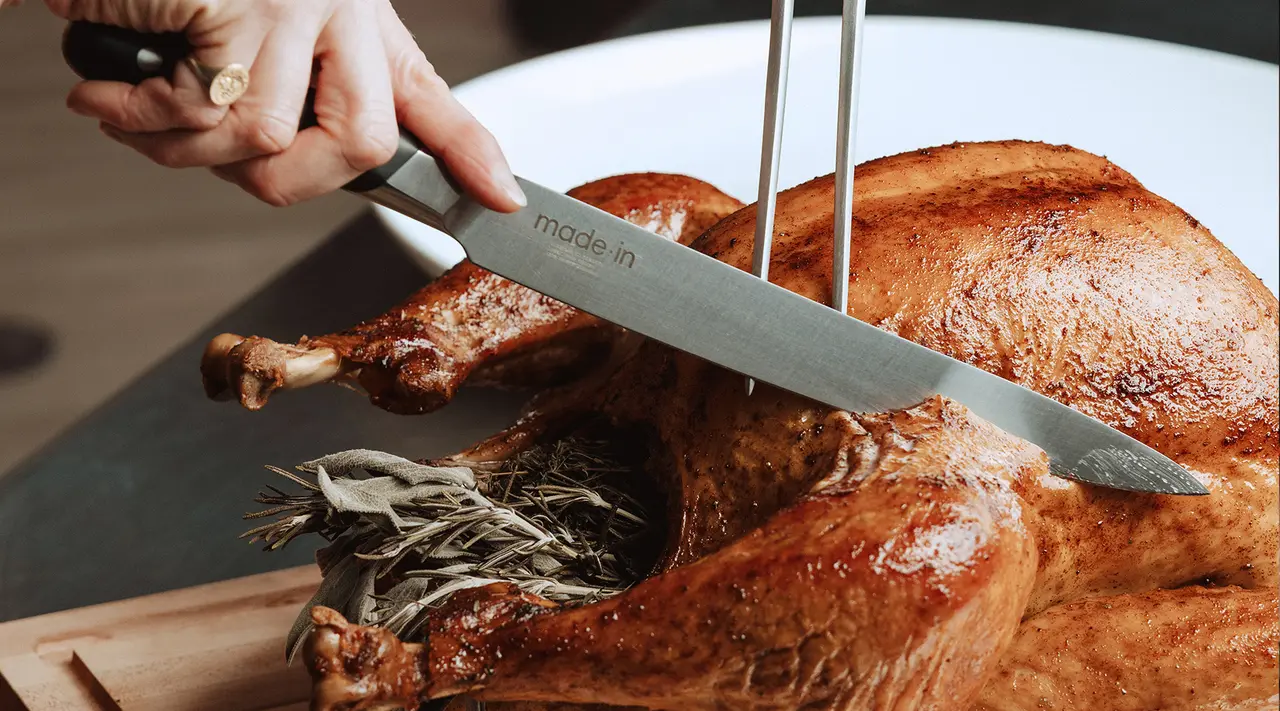When it’s time to carve up a Sunday roast or Thanksgiving turkey, there’s no tool more up to the job than a carving knife. Characterized by its long, thin blade that ensures even and easy slices, this knife is the best (and most traditional) tool for serving large cuts of meat.
Here’s more information about this surprisingly versatile knife, and why it’s an essential in any knife block.
What Is a Carving Knife?

A carving knife is used almost exclusively for carving all types of meat, from brisket to holiday mains. Typically, they feature a long, thin blade with a pronounced tip that improves precision and maneuverability around bone, fat, and cartilage.
A variety of knives can be used for cutting raw proteins, from fillet knives (ften used for fish) to cleavers (common amongst butchers). Unlike these, a carving knife is used to slice and serve cooked meat.
Carving Knife vs. Chef Knife
If you already have a multi-use chef knife, you may wonder if it’s necessary to add a carving knife to your roster. A chef knife possesses a wider blade than a carving knife and will require more effort to cut through, which can result in jagged, uneven slices. A carving knife has a thinner, longer blade (ours is 9” long), specifically designed for clean, even slices of any width, from paper-thin deli-style slices to thick rounds.
Another key difference between these two blades is the tip of the blade. While both chef and carving knives possess sharp tips, the point at the end of a carving knife is much more narrow and pronounced. This allows for easy maneuvering around the contours of a roast to get every piece of meat off the bone.
While a chef knife can make do with cutting the odd steak or roast, a carving knife is worth investing in if you regularly cook and serve large amounts of meat (or are always on tap for hosting holiday dinners).
Do You Really Need a Carving Knife?

A carving knife may not be the most reached for one on your knife block, but is a tool that you’ll be endlessly grateful for when you do need it.
Benefits of Using a Carving Knife
There are many reasons we think this is an essential blade in any knife block, but first let’s dive into the unique benefits of using a carving knife.
Cleaner Cuts
The most important benefit of using a carving knife is the easy, clean slices you can achieve. Hacked-up holiday turkeys or uneven steak slices will be a thing of the past, thanks to the long, pointed blade that deftly works through even the toughest cuts—your guests will thank you.
Improved Presentation
While a meal is a meal no matter what it looks like, the clean, even slices that a carving knife helps to achieve makes for a much more aesthetically pleasing presentation than jagged, uneven, hacked off slices. This is especially important when you want to impress on special occasions and holidays—not to mention, pays due respect to the bird or roast you just spent hours preparing.
Increased Efficiency
No one wants to delay dinner because the star of the table was too tough to carve in a timely manner. Luckily, a dedicated carving knife helps to speed up the carving process (even for full birds or large roasts) so you can spend less time cutting and more time enjoying your meal.
When to Use a Carving Knife
As its name suggests, a carving knife is the ideal tool for carving large, even slices of any type of meat, from poultry to pork. The shape of this knife also makes it useful for carving clean pieces of other large or unwieldy fruits or vegetables, like pumpkins and watermelon.
How to Choose a Carving Knife

When picking out a carving knife from the wide variety of options out there, there are a few factors to keep in mind when shopping to ensure you’re picking out the best one for you.
Blade Length
A carving knife’s greatest asset is the length of its blade—this is what allows it to carve neatly and evenly through meat, resulting in a picture-perfect slice. The length of our blade is 9” (1" longer than our Chef Knife), which ensures borh clean cuts and easy maneuvering.
Blade Material
A knife is only as good as its blade, especially when considering the material the blade is constructed out of. Ours is full tang and fully forged, which results in a blade with an unparalleled cutting experience that maintains its edge, meaning less care and maintenance (and more carving).
Handle Material
Less important than blade construction but an important factor of overall knife design, the knife handle material dictates care and maintenance. Ours is made from our signature slip-resistant black POM handle, ensuring a comfortable, ergonomic grip while carving your holiday meal.
Ready to Shop?
Though it may see the most action during the holidays, a carving knife is a year round essential that fills a necessary role in any knife block. If you’re looking to invest in one, our Carving Knife and Fork set has everything you need for successful carving and serving a beautifully presented dish for a casual dinner or holiday meal.































